
Everyone in life has problems and football turns out to be the cheapest therapy. ~ Diego Forlán, World Cup 2010 Golden Ball winner
Uruguay's Forlán here declared one of the simple truths in the life of a football fan. His namesake and fellow South American in the 1980s, a couple of generations before him, was therapy to a whole city in Europe. In his seven tumultuous, rambunctious years in southern Italy, Diego Armando Maradona rose to global superstardom. His posters and murals adorned walls from Buenos Aires to Napoli and from Sevilla to Calcutta.
A lot of Ballon d'Or winners (6) have played for Barcelona. And while Maradona was at the Nou Camp for two seasons (1982-84), it is not where his legacy was cemented. He instead attained cult status in Naples - one of the oldest continuously-inhabited urban areas in the world. The city had a vivid history but not in the footballing sense. He made a move to Napoli in 1984, shattering the world record transfer fee for the second time (£5 million), and was the only player since World War II to do so, following his move from Boca Juniors to Barcelona two years earlier.
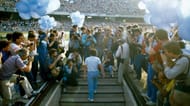
To paraphrase English historian John Foot, Napoli seemed a strange choice to make at that time. Serie A was the richest and most powerful league in the world. All the best players went to Italy, particularly to the northern giants - AC Milan, Juventus, Inter Milan. But Napoli, in their history, had won two cups. That was it. They never won the championship (Scudetto). They were not a successful team. They were not even a club that looked like they were going to be successful.
The port city of Naples was teemed with football enthusiasts (Napoli Ultras) who, for all their passion, had disproportionately few trophies to showboat. But now, they had the best player in the world. A bankrupt city was doubling-down to sign the most expensive player in the world in a bizarrely Italian way. It was a heady cocktail that, if nothing, promised entertainment - some on the ground and a lot more off of it.
The technical uniqueness of Maradona
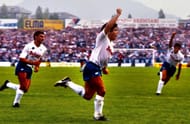
As per the Argentine icon, football is a game of deceit. Without a shadow of a doubt, he was the greatest exponent of the feint. He would pretend to move one way only to slither the other, leaving imbalanced opponents tumbling on the floor, and then just to show off, he would cut back to go another way. He zig-zagged through many defences even as defenders would try to chop his feet off with furious challenges of ever-increasing intensity.
Maradona's low centre of gravity kept him from falling and helped him dribble as tackles flew in thick and fast. Despite this, he would survey the surrounding for those defence-splitting passes that left many full-backs thoroughly embarrassed and the crowd cheering in joy. He could take a lot of hits on ankles, on shins, on feet, on calves, even on his face, and still move on in his pursuit of scoring and assisting.
In a rough, tough, and cantankerous league, he brought beauty. On his good days, which often were every other weekend, he was damn near impossible to play against. He brought a Latin American enthusiasm to every game and played with speed, rock solid-balance, jaw-dropping technique, immense pride, and pure love for football.
The peak of his career
From a relegation-threatened outfit in 1983-84 to a top-three club in 1985-86, the progress made by Napoli was there for all to see. The racist chants by northern clubs were an underhand acknowledgement of their growing threat. Maradona fed off this vitriol and in his second season (1985-86), the club improved by leaps and bounds.
The diminutive star went into the 1986 World Cup in México in good form and Argentina heavily relied on their captain's brilliance. Realms have been written about his sterling performances against England and Belgium in the quarter-finals and the semi-finals respectively - during which he scored a brace each including the Hand of God and the Goal of the Century.
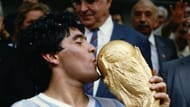
Through sheer force of desire, he dragged them into the finals and to the brink of history. When the final against West Germany was locked at 2-2 in the dying minutes, he made a delightful pass to set striker Jorge Luis Burruchaga up to score the winning goal. This is one of the rare instances where a great player single-handedly led his team to World Cup glory. It was pure Maradona. At 25, he had the world at his feet and a World Cup trophy to cradle.
Napoli's first-ever Scudetto
Maradona returned to Italy as a World Cup winner and the press could never get enough of him. However, there's also a cost to fame. He was in a relationship with teenage sweetheart Claudia Villafañe but he had endured his fair share of misdemeanours and flings. One of them, in particular, caught up with him. He had sired a kid in the spring with his sister's friend, Cristiana Sinagra, but refused to take a paternity test and the media wouldn't let him off.
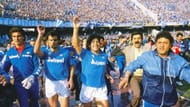
In the midst of this all, in his third season on 10 May 1987, the Scudetto was delivered- the first in Napoli's history. The city was awash with the blue colours of the club - drunk on the feat as parties went on for days on end. The Coppa Italia followed shortly.
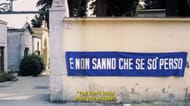
When Maradona had escaped from Barcelona, nobody expected him to win titles at Napoli. In three seasons, he turned around the club's fortunes and an entire city's narrative. The port lying at the ankle of Italy by the Mediterranean Sea was now a compelling new force, led by the best player in the world.
The other side of Maradona
Notwithstanding his anointment as a god, he had Dionysian streaks - the sensual, spontaneous, and emotional aspects of human nature were alive and popping in his blood. These aspects eventually led him to give in to temptations of flesh, money, food, and desire. He had discovered cocaine but was not addicted to it yet and Naples still revered and protected him (we will come to that later). A bravura performance will be followed by wee-hour fiestas, night-outs at discothèques and raves that will then quickly make way for frantic training to get fit for the next weekend's game.
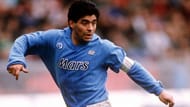
In the next two seasons, the club finished second in the league. In 1987-88 they lost their final three league matches to hand the title to AC Milan and were accused by fans of doing it at the behest of the Italian mafia. In 1988-89, they won the UEFA Cup, becoming the champions of Europe. In the aftermath of the celebration, Maradona asked the club president Corrado Ferlaino, the man who bought him, to sell him to another club. Ferlaino refused. Somehow for Maradona, anger begets genius.
While he fell into the vortex of drugs to try and escape the captivity, frequenting after-parties in hotels and strip clubs, the results kept coming on the pitch. Napoli were topping the league again. Ferlaino and the press were believed to have been aware that someone else was standing in to take the drug-tests for their captain. The city was protecting him. In April 1990, the second Scudetto was secured and another page was added to the folklore.
This pint-sized Argentine was like candy-flavoured cocaine for the fans - something so enamouring to their veins that letting go was not an option. Naples-born World Cup and Ballon d'Or winner Fabio Cannavaro, who was a ball boy at the club and who trained with the great man as a teenager, said:
“Maradona is a God to the people of Naples. He changed history. In 80 years, we had always suffered, fighting against relegation, yet in seven seasons with him we won two leagues, a UEFA Cup, two Italian Cups. I’m a fan too and to live those years (as a child) with Maradona in Napoli was incredible. Being on the pitch when they won the Scudetto was amazing.”
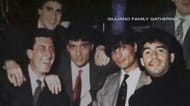
Cocaine first became a necessity and then transitioned into an unshakeable addiction for Maradona, who was as respected as the city's patron saint Gennaro.
The Camorra Mafiosi was his conduit to the white powder. The Giuliano clan knew and understood that this was how they can have him pinned under their thumb. Everyone wanted to be in his reflected glory, even if by subterfuge or malice.
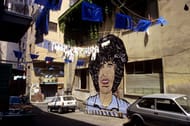
Serbian film director and Palme d'Or winner Emir Kusturica was in awe of the magnitude of the Argentine's hold on people.
"I asked myself, 'Who is this man? Who is this footballing magician, this Sex Pistol of international football, this cocaine victim who kicked the habit, looked like Falstaff and was as weak as spaghetti?' If Andy Warhol had still been alive, he would have definitely put Maradona alongside Marilyn Monroe and Mao Tse-tung. I'm convinced that if he hadn’t been a footballer, he'd've become a revolutionary."
The beginning of the end
1990. It was time for the World Cup in Italy. In the semi-finals, it was Italy versus Argentina, in Naples. Maradona played up the north-south divide and said that nothing would make him happier than the support of the Neapolitans for Argentina. There was one problem though - they had to do it against their own country.
Italians supported their country and it felt odd to play at his own club ground without much support. Yet, after a tense game, penalties were needed to separate the teams as they were locked 1-1 after extra-time. Napoli and Argentina's Maradona scored the decisive penalty. And that was it.
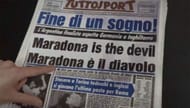
It is here that the protagonist had stayed long enough to be painted as an anti-hero. His revolutionary antics became revolting. He went from being revered to reviled. From Dios (God) to Diablo (Devil). The whole country turned on him. It became easy to frame him in drug possession and trafficking cases. No one was going to rescue him. That's exactly what happened through the wiretapping operation called Operation China in January 1991.
The state, tax officials, and police were all gunning for Maradona and the superstar no longer had the mafia protection he initially enjoyed. With no recourse, he pleaded guilty, taking a suspended sentence of 14 months and a hefty fine of 5 million liras. In April that year, he failed a drug test and was banned until June 1992.
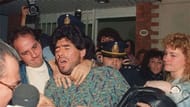
Naples took out a lot from him and he gave the city a lot. They still loved him but it was impossible for him to carry on in Italy. He arrived in the city as a saviour, welcomed by thousands, but he left alone. He fled, fearing arrest, and his best days appeared to be behind him.
After serving the 15-month ban, he moved to Spanish club Sevilla in 1992. He eventually returned to Argentina to play for Newell's Old Boys (1993-94). His career petered off where it rose from as he retired after a two-year stint with Boca Juniors.
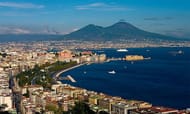
Naples is a fascinating city and Napoli a bustling club, both feeding off each other. Naples invented pizza, crafted sfogliatella, and is film-maker Vittorio De Sica's home - and even he couldn't direct this story. It was the centre of the cholera epidemics, was at the receiving end of the fury of Mount Vesuvius's lava and was the most bombed Italian city during World War II.
It is the venue of the San Paulo stadium where Maradona displayed his wizardry for 7 years. A kid, born in a pauper of a neighbourhood in Buenos Aires in the poorest of decades, went on to mean so much to the Neapolitans - another city quite similar to his borough. The revealing documentary Diego Maradona (2019) by Asif Kapadia has an uncredited TV host expressing what this man meant to Naples.
Neapolitans had inside them, more than God perhaps, Maradona.
His stint in Naples was what made the man and fed his myth. It was ever-fascinating and merits revisiting. Seldom has a player and a city been in such a stormy affair, with their trajectories intrinsically linked. Maradona is immortal in Naples and the city beats in his tragic heart.
